UK Ranks 7th in 2018 EU Broadband Connectivity Progress Report
The European Commission has publish their 2018 Digital Economy and Society Index (DESI), which uses data from 2017 and 2018 to reveal the United Kingdom’s progress toward the EU’s Digital Agenda goals (e.g. NGA 30Mbps+ broadband for all by 2020). This year we remain ranked 7th out of 28 member states.
In case anybody has forgotten, the Digital Agenda for Europe (DAE) set several targets but the main ‘Connectivity’ related one called for every home to gain access to a 30Mbps+ capable Next Generation Access (NGA) broadband connection by the year 2020. On top of that it also called for 50% of consumers to be “subscribed” to a 100Mbps+ service (not the same as coverage).
The good news is that the United Kingdom continues to belong to the “high performing cluster of countries” and we’re particularly strong in the all-important area of digital connectivity, where we also rank 7th and that’s an improvement from 8th last year. Overall our general rank is 7th – across all categories – and that’s unchanged from 2017.
Advertisement
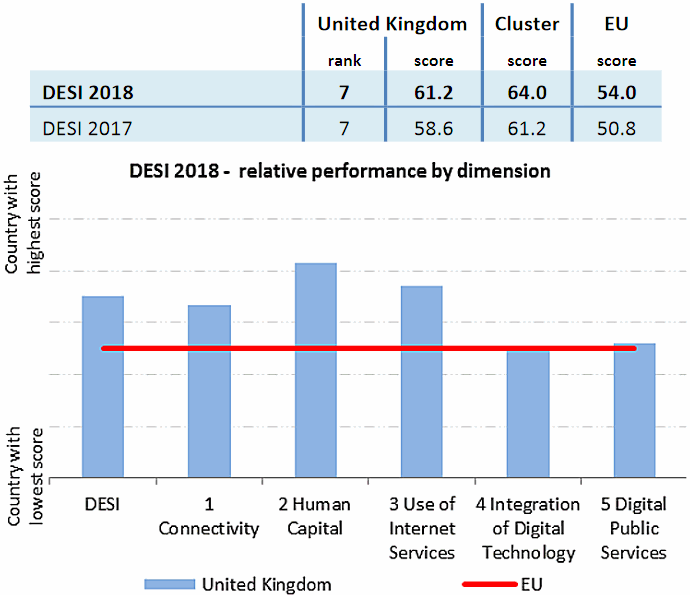
The UK coverage of NGA style broadband networks (FTTC, FTTH, DOCSIS etc.) has increased to 94% (compared with 80% across the EU), which puts us ahead of major economies like Germany, France, Italy and Spain but behind several other countries (e.g. Malta, Belgium, Netherlands, Portugal, Denmark and Luxembourg). We also do well for rural coverage.

Some people may be surprised by this result, particularly with so many other EU countries now investing much more heavily than the UK in Gigabit capable “full fibre” (FTTP/H) networks, but the reason predominantly relates to Openreach’s (BT) focus on deploying hybrid-fibre (FTTC / VDSL2) upgrades that are cheap and relatively quick to rollout. By comparison FTTP/H is much faster but also very expensive and slow to deploy.
On top of that Virgin Media’s Hybrid Fibre Coax (HFC) based DOCSIS cable network can now reach about half of the country with ultrafast broadband speeds of 350Mbps and they aim to cover around 60% of UK premises by the end of 2019 or 2020.
Advertisement
Overall this focus on hybrid fibre gives the UK a good standing in NGA / “superfast broadband” (30Mbps+) availability, but we are much weaker when looking at “ultrafast” (100Mbps+) connections. The second chart below only shows FTTP/H availability and as you can see the UK is barely even visible and we’re well behind almost everybody else.
As above, FTTP and Docsis 3.0 cable networks are both capable of delivering ultrafast fixed line connectivity. Cable covers 45%, while FTTP covers 27% of EU homes. However cable and FTTP networks do tend to overlap, and mainly cover urban areas. The EU estimates that some 57% of homes have access to at least one of these ultrafast technologies.
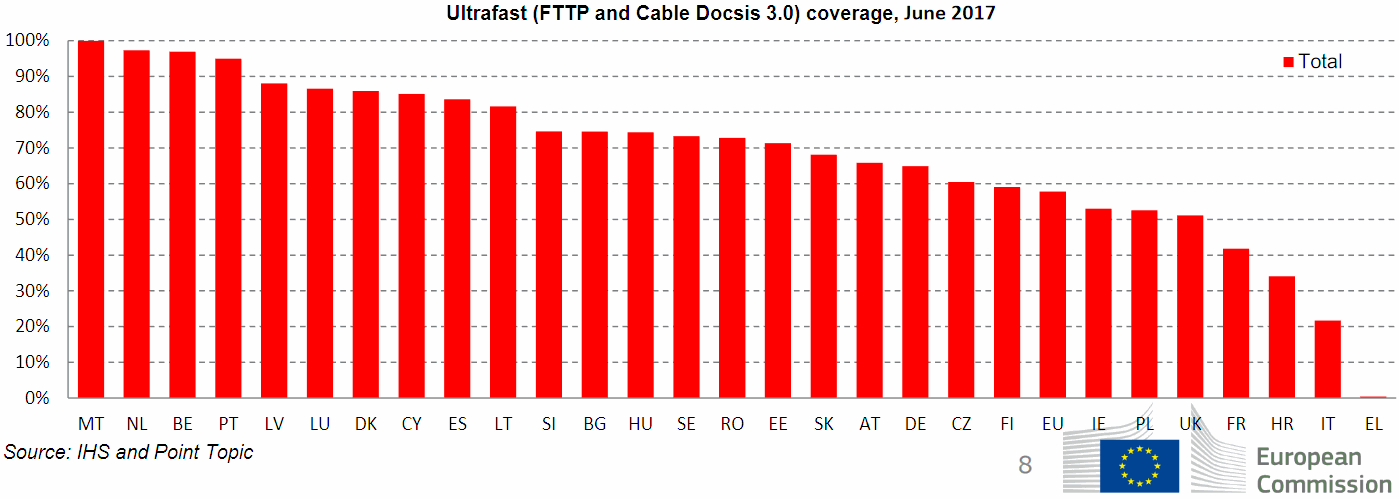
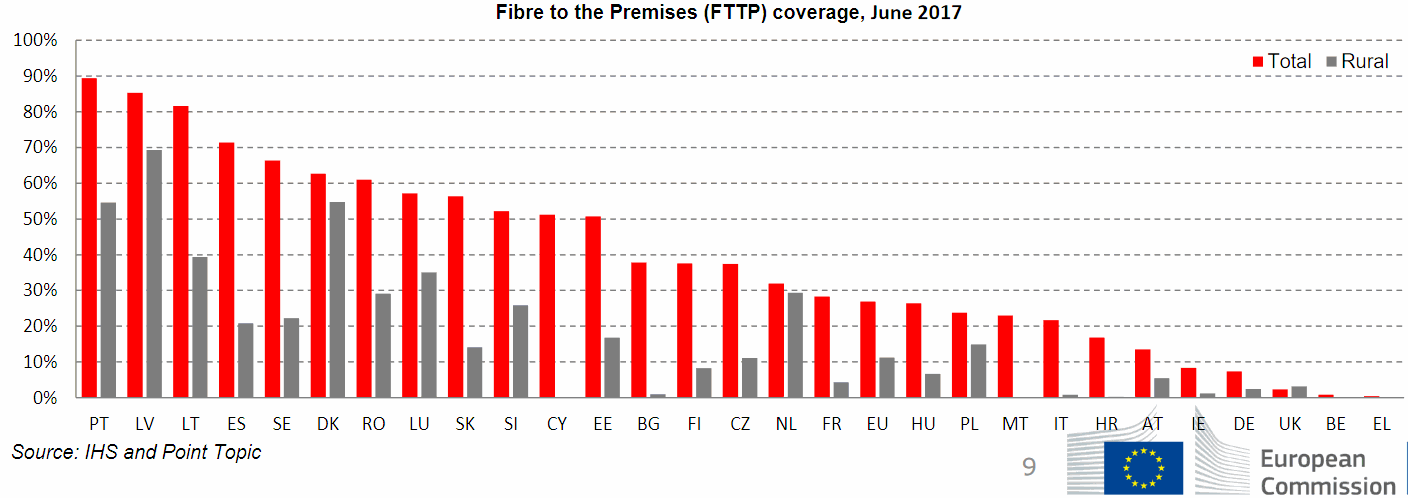
Advertisement
The good news is we’re finally starting to turn a corner and it looks like there will be a rapid improvement in national FTTP/H coverage over the next few years. At present only around 3-4% of UK premises can access such a connection (Ofcom data) but check out our ‘Summary of Full Fibre Broadband Plans and Investment‘ for a better understanding of what’s coming.
On top of that the EU’s data has yet to factor in the future impact of hybrid fibre G.fast technology, which can also deliver ultrafast speeds. Openreach are deploying that to 10 million UK premises by 2020. The EU’s data is currently too old to reflect the start of this, although Virgin Media’s overlap in urban areas may overshadow it but in time that may change.
Elsewhere 4G Mobile (Mobile Broadband) coverage has reached 98% in the UK (households), which compares with 91% across the EU.
EC Report Statement
There are several challenges regarding broadband deployment in the UK. Four per cent of the UK premises have no access to decent broadband of at least 10 Mbps. Regarding NGA coverage the urban-rural digital divide is still obvious (rural coverage was at 82 %). The share of FTTH/B connections (1 %) is one of the lowest in the EU.
The regulatory [10Mbps] USO and the measures set out in the UK digital strategy can bring improvements in this regard. The potential of the transposed Broadband Cost Reduction Directive, to contribute to the deployment of high speed broadband connections is not fully exploited yet. The benefits of the legal separation of BT and Openreach, which is not fully completed, are not visible on the market yet. Ofcom’s increased focus on consumer matters and targeted actions in this regard bring clear benefits.
At this point some may recall that in 2016 the European Commission proposed a new non-binding Gigabit Society target for “all European households” to get a minimum download speed of 100Mbps+ by 2025, with businesses and the public sector being told to expect 1Gbps+ (here). Since then this seems to have been swept under the carpet and the main focus continues to reflect the 2020 DAE goals.
At present the UK government’s most recent data claims that 95% of premises can access a superfast broadband connection and they expect this to reach 98% by the end of 2020, with the final 2% being supported by the new legally-binding 10Mbps USO. However as time progresses it looks like the UK could find itself lagging behind as the focus turns more toward FTTP/H and rural coverage of “ultrafast” services.
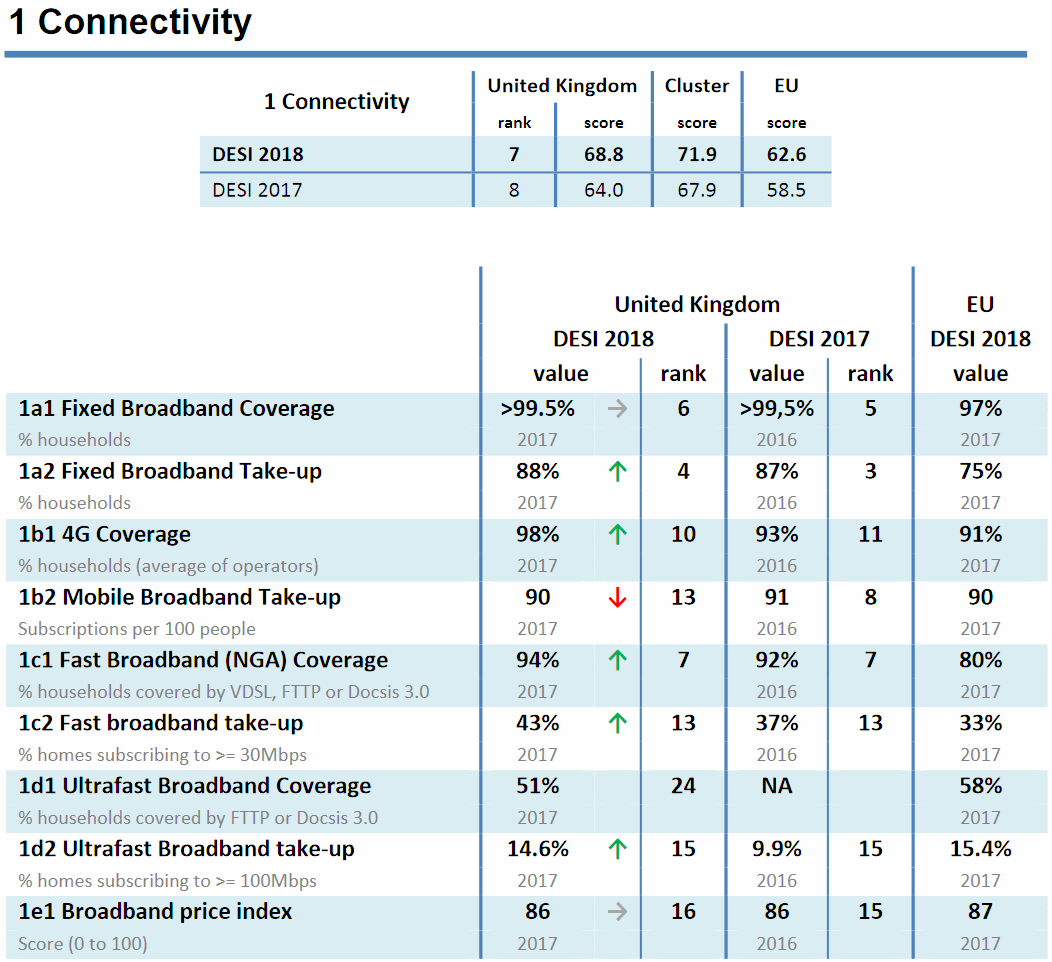
The Digital Economy and Society Index 2018 (DESI)
http://ec.europa.eu/../uk-desi_2018-country-profile_eng.pdf
Mark is a professional technology writer, IT consultant and computer engineer from Dorset (England), he also founded ISPreview in 1999 and enjoys analysing the latest telecoms and broadband developments. Find me on X (Twitter), Mastodon, Facebook, BlueSky, Threads.net and Linkedin.
« Which Suggest UK ISPs May Get Average Broadband Speeds Wrong
Openreach Hints at SOGEA UK Standalone FTTC Broadband Prices »






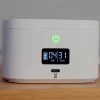

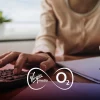








































Comments are closed